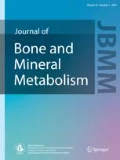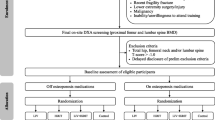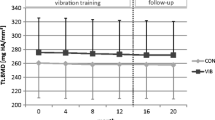Abstract
Introduction
This study determined the effects of whole-body vibration (WBV) and high-impact exercises on postmenopausal women.
Materials and methods
In this randomized controlled 6-month interventional trial, 58 eligible postmenopausal women were assigned to WBV training group, high-impact training group, or control group. Bone mineral density (BMD) of the lumbar spine and femur were measured by dual-energy X-ray absorptiometry. Additionally, the serum osteocalcin (OC) and C-terminal telopeptide of type I collagen levels were also measured. The functional mobility was assessed using the Timed Up and Go (TUG) test, and fall index was measured using static posturography. The health-related quality of life (HRQoL) and depressive symptoms were assessed using the Quality of Life Questionnaire of the European Foundation for Osteoporosis and Beck Depression Inventory, respectively.
Results
The BMD at the femoral neck (p = 0.003) and L2–L4 (p = 0.005) regions increased significantly in the WBV group compared to the control group. However, in the high-impact exercise group there were no significant effects on the lumbar spine and femoral neck. The serum OC decreased significantly in the WBV group and increased significantly in both the high-impact exercise and control groups (p < 0.001). The TUG scores decreased significantly in both training groups compared to the control group (p < 0.05). Finally, in both exercise groups, HRQoL and depressive symptoms improved (p < 0.001).
Conclusions
Our data suggest that the WBV can prevent bone loss in postmenopausal women. These findings also indicate that WBV and high-impact training programs improve functional mobility, HRQoL and depressive symptoms in postmenopausal women.

Similar content being viewed by others
References
Nikander R, Sievänen H, Heinonen A, Daly RM, Uusi- Rasi K, Kannus P (2010) Targeted exercise against osteoporosis: a systematic review and meta-analysis for optimising bone strength throughout life. BMC Med 8:47
Wysocki A, Butler M, Shamliyan T, Kane RL (2011) Whole-body vibration therapy for osteoporosis: state of the science. Ann Intern Med 155:680–686
Judex S, Rubin CT (2010) Is bone formation induced by high-frequency mechanical signals modulated by muscle activity? J Musculoskelet Neuronal Interact 10:3–11
Tezval M, Biblis M, Sehmisch S, Schmelz U, Kolios L, Rack T, Stuermer KM, Stuermer EK (2011) Improvement of femoral bone quality after low-magnitude, high-frequency mechanical stimulation in the ovariectomized rat as an osteopenia model. Calcif Tissue Int 88:33–40
Slatkovska L, Alibhai SM, Beyene J, Cheung AM (2010) Effect of whole-body vibration on BMD: a systematic review and meta-analysis. Osteoporos Int 21:1969–1980
Sitjà-Rabert M, Rigau D, Fort Vanmeerghaeghe A, Romero-Rodríguez D, Bonastre Subirana M, Bonfill X (2012) Efficacy of whole body vibration exercise in older people: a systematic review. Disabil Rehabil 34:883–893
Oliveira LC, Oliveira RG, Pires-Oliveira DA (2016) Effects of whole body vibration on bone mineral density in postmenopausal women: a systematic review and meta-analysis. Osteoporos Int 27:2913–2933
Turner S, Torode M, Climstein M, Naughton G, Greene D, Baker MK, Fiatarone Singh MA (2011) A randomized controlled trial of whole body vibration exposure on markers of bone turnover in postmenopausal women. J Osteoporos 2011:710387
de Kam D, Smulders E, Weerdesteyn V, Smits-Engelsman BC (2009) Exercise interventions to reduce fall-related fractures and their risk factors in individuals with low bone density: a systematic review of randomized controlled trials. Osteoporos Int 20:2111–2125
Orr R (2015) The effect of whole body vibration exposure on balance and functional mobility in older adults: a systematic review and meta-analysis. Maturitas 80:342–358
Gusi N, Raimundo A, Leal A (2006) Low-frequency vibratory exercise reduces the risk of bone fracture more than walking: a randomized controlled trial. BMC Musculoskelet Disord 7:92
Verschueren SM, Roelants M, Delecluse C, Swinnen S, Vanderschueren D, Boonen S (2004) Effect of 6-month whole body vibration training on hip density, muscle strength, and postural control in postmenopausal women: a randomized controlled pilot study. J Bone Miner Res 19:352–359
Verschueren SM, Bogaerts A, Delecluse C, Claessens AL, Haentjens P, Vanderschueren D, Boonen S (2011) The effects of whole-body vibration training and vitamin D supplementation on muscle strength, muscle mass, and bone density in institutionalized elderly women: a 6-month randomized, controlled trial. J Bone Miner Res 26:42–49
Russo CR, Lauretani F, Bandinelli S, Bartali B, Cavazzini C, Guralnik JM, Ferrucci L (2003) High-frequency vibration training increases muscle power in postmenopausal women. Arch Phys Med Rehabil 84:1854–1857
Bianchi ML, Orsini MR, Saraifoger S, Ortolani S, Radaelli G, Betti S (2005) Quality of life in post-menopausal osteoporosis. Health Qual Life Outcomes 3:78
Li WC, Chen YC, Yang RS, Tsauo JY (2009) Effects of exercise programmes on quality of life in osteoporotic and osteopenic postmenopausal women: a systematic review and meta-analysis. Clin Rehabil 23:888–896
Rimer J, Dwan K, Lawlor DA, Greig CA, McMurdo M, Morley W, Mead GE (2012) Exercise for depression. Cochrane Database Syst Rev 7:CD004366
Kohen-Raz R (1991) Application of tetra-ataxiametric posturography in clinical and developmental diagnosis. Percept Mot Skills 73:635–656
Podsiadlo D, Richardson S (1991) The timed “Up & Go”: a test of basic functional mobility for frail elderly persons. J Am Geriatr Soc 39:142–148
Kocyigit H, Aydemir O, Fisek G, Olmez N, Memis A (1999) Validity and reliability of Turkish version of Short-form 36: a study of a patients with romatoid disorder. J Drug Therapy 12:102–106
Beck AT, Ward CH, Mendelson M, Mock J, Erbaugh J (1961) An inventory for measuring depression. Arch Gen Psychiatry 4:561–571
Ruan XY, Jin FY, Liu YL, Peng ZL, Sun YG (2008) Effects of vibration therapy on bone mineral density in postmenopausal women with osteoporosis. Chin Med J (Engl) 121:1155–1158
Lai CL, Tseng SY, Chen CN, Liao WC, Wang CH, Lee MC, Hsu PS (2013) Effect of 6 months of whole body vibration on lumbar spine bone density in postmenopausal women: a randomized controlled trial. Clin Interv Aging 8:1603–1609
Rubin C, Pope M, Fritton JC, Magnusson M, Hansson T, McLeod K (2003) Transmissibility of 15-hertz to 35-hertz vibrations to the human hip and lumbar spine: determining the physiologic feasibility of delivering low-level anabolic mechanical stimuli to skeletal regions at greatest risk of fracture because of osteoporosis. Spine (Phila Pa 1976) 28:2621–2627
Rubin C, Turner AS, Mallinckrodt C, Jerome C, McLeod K, Bain S (2002) Mechanical strain, induced noninvasively in the high frequency domain, is anabolic to cancellous bone, but not cortical bone. Bone 30:445–452
Rubin C, Judex S, Qin YX (2006) Low-level mechanical signals and their potential as a non-pharmacological intervention for osteoporosis. Age Ageing 35:ii32–ii36
von Stengel S, Kemmler W, Engelke K, Kalender WA (2011) Effects of whole body vibration on bone mineral density and falls: results of the randomized controlled ELVIS study with postmenopausal women. Osteoporos Int 22:317–325
Rubin C, Recker R, Cullen D, Ryaby J, McCabe J, McLeod K (2004) Prevention of postmenopausal bone loss by a low-magnitude, high-frequency mechanical stimuli: a clinical trial assessing compliance, efficacy, and safety. J Bone Miner Res 19:343–351
Slatkovska L, Alibhai SM, Beyene J, Hu H, Demaras A, Cheung AM (2011) Effect of 12 months of whole-body vibration therapy on bone density and structure in postmenopausal women: a randomized trial. Ann Intern Med 155:668–679
Zernicke R, MacKay C, Lorincz C (2006) Mechanisms of bone remodeling during weight-bearing exercise. Appl Physiol Nutr Metab 31:655–660
Bemben DA, Palmer IJ, Bemben MG, Knehans AW (2010) Effects of combined whole-body vibration and resistance training on muscular strength and bone metabolism in postmenopausal women. Bone 47:650–656
Zha DS, Zhu QA, Pei WW, Zheng JC, Wu SH, Xu ZX, Li T, Chen JT (2012) Does whole-body vibration with alternative tilting increase bone mineral density and change bone metabolism in senior people? Aging Clin Exp Res 24:28–36
Liu PY, Brummel-Smith K, Ilich JZ (2011) Aerobic exercise and whole-body vibration in offsetting bone loss in older adults. J Aging Res 2011:379674
Kelley GA, Kelley KS, Kohrt WM (2012) Effects of ground and joint reaction force exercise on lumbar spine and femoral neck bone mineral density in postmenopausal women: a meta-analysis of randomized controlled trials. BMC Musculoskelet Disord 13:177
Howe TE, Shea B, Dawson LJ, Downie F, Murray A, Ross C, Harbour RT, Caldwell LM, Creed G (2011) Exercise for preventing and treating osteoporosis in postmenopausal women. Cochrane Database Syst Rev 7:CD000333
Kemmler W, Lauber D, Weineck J, Hensen J, Kalender W, Engelke K (2004) Benefits of 2 years of intense exercise on bone density, physical fitness, and blood lipids in early postmenopausal osteopenic women: results of the Erlangen Fitness Osteoporosis Prevention Study (EFOPS). Arch Intern Med 164:1084–1091
Korpelainen R, Keinänen-Kiukaanniemi S, Heikkinen J, Väänänen K, Korpelainen J (2006) Effect of impact exercise on bone mineral density in elderly women with low BMD: a population-based randomized controlled 30-month intervention. Osteoporos Int 17:109–118
Newstead A, Smith KI, Bruder J, Keller C (2004) The effect of a jumping exercise intervention on bone mineral density in postmenopausal women. J Geriatr Phys Ther 27:47–52
Bassey EJ, Rothwell MC, Littlewood JJ, Pye DW (1998) Pre- and postmenopausal women have different bone mineral density responses to the same high-impact exercise. J Bone Miner Res 13:1805–1813
Bogaerts A, Delecluse C, Boonen S, Claessens AL, Milisen K, Verschueren SM (2011) Changes in balance, functional performance and fall risk following whole body vibration training and vitamin D supplementation in institutionalized elderly women. A 6-month randomized controlled trial. Gait Posture 33:466–472
Hourigan SR, Nitz JC, Brauer SG, O’Neill S, Wong J, Richardson CA (2008) Positive effects of exercise on falls and fracture risk in osteopenic women. Osteoporos Int 19:1077–1086
Bruyere O, Wuidart MA, Di Palma E, Gourlay M, Ethgen O, Richy F, Reginster JY (2005) Controlled whole body vibration to decrease fall risk and improve health-related quality of life of nursing home residents. Arch Phys Med Rehabil 86:303–307
Buatois S, Gueguen R, Gauchard GC, Benetos A, Perrin PP (2006) Posturography and risk of recurrent falls in healthy non-institutionalized persons aged over 65. Gerontology 52:345–352
de Oliveira Ferreira N, Arthuso M, da Silva R, Pedro AO, Neto AM, Costa-Paiva L (2009) Quality of life in women with postmenopausal osteoporosis: correlation between QUALEFFO 41 and SF-36. Maturitas 62:85–90
Angin E, Erden Z (2009) The effect of group exercise on postmenopausal osteoporosis and osteopenia. Acta Orthop Traumatol Turc 43:343–350
Furness TP, Maschette WE (2009) Influence of whole-body vibration platform frequency on neuromuscular performance of community-dwelling older adults. J Strength Cond Res 23:1508–1513
Papaioannou A, Adachi JD, Winegard K, Ferko N, Parkinson W, Cook RJ, Webber C, McCartney N (2003) Efficacy of home-based exercise for improving quality of life among elderly women with symptomatic osteoporosis-related vertebral fractures. Osteoporos Int 14:677–682
Cooney GM, Dwan K, Greig CA, Lawlor DA, Rimer J, Waugh FR, McMurdo M, Mead GE (2013) Exercise for depression. Cochrane Database Syst Rev 9:004366
Milliken LA, Wilhelmy J, Martin CJ, Finkenthal N, Cussler E, Metcalfe L, Guido TA, Going SB, Lohman TG (2006) Depressive symptoms and changes in body weight exert independent and site-specific effects on bone in postmenopausal women exercising for 1 year. J Gerontol A Biol Sci Med Sci 61:488–494
Acknowledgements
The current study was registered in the Scientific Research Projects Unit of the Istanbul University prior to beginning of the study and partly funded by the same unit (T-6927). The trial was retrospectively registered on www.clinicaltrials.gov (NCT03910348). The authors of the study just had control on the study design, data collection and analysis, also on interpretations of results or writing of the paper. This work was presented at the American Society for Bone and Mineral Research (ASBMR) annual meeting October 12-16, 2012 in Minneapolis, Minnesota, USA as a plenary poster presentation. It received the 2012 ASBMR Young Investigator Travel Grant.
Author information
Authors and Affiliations
Corresponding author
Ethics declarations
Conflict of interest
The author declares that they have no competing interests.
Ethical standards
All procedures performed in studies involving human participants were in accordance with the ethical standards of the institutional and/or national research committee and with the Helsinki declaration.
Additional information
Publisher's Note
Springer Nature remains neutral with regard to jurisdictional claims in published maps and institutional affiliations.
About this article
Cite this article
Sen, E.I., Esmaeilzadeh, S. & Eskiyurt, N. Effects of whole-body vibration and high impact exercises on the bone metabolism and functional mobility in postmenopausal women. J Bone Miner Metab 38, 392–404 (2020). https://doi.org/10.1007/s00774-019-01072-2
Received:
Accepted:
Published:
Issue Date:
DOI: https://doi.org/10.1007/s00774-019-01072-2




